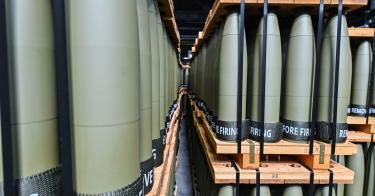The State Department has finally moved to speed up the process to approve military equipment sales to allies. The changes made include developing a regional approach to arms transfers, prioritizing customers based on U.S. national security interests, and streamlining State’s internal processes.
The changes are laudable, but they won’t get to the root of the problem.
Providing weapons to friends and allies serves U.S. security interests. It creates more capable allies who can better defend themselves. It forges tighter relationships with our friends by creating a continuing need for spare parts and maintenance support. And it supports U.S. jobs and the economy.
Unfortunately, to complete U.S. arms sales usually takes years—time countries like Ukraine and Taiwan cannot afford. To avoid these lengthy delays, countries have started going elsewhere to obtain needed weapons. Look no further than Poland, which recently signed contracts with South Korea to buy tanks and artillery pieces. Normally, the United States would be the seller of choice for items like these.
>>> In Deterring China, Dialogue Is No Substitute for Budgets, Hard Power
While simplifying and expediting weapons sales is a step in the right direction, it will not resolve the core issue behind the backlog of U.S. weapons sales: an extremely limited U.S. defense industrial base capacity.
With powers like China and Russia becoming increasingly aggressive, the United States needs to find ways to speed up arms sales to its allies and partners for its own sake as well as theirs. Last December, Japan announced that it intends to increase its defense spending by 60 percent. To reach its long-term goals, Japan will need to purchase more U.S.-made weapons like Tomahawk missiles. If the U.S. is going to meet these needs, things must change.
The State Department’s 10-point plan aims to streamline the arms sales process to ensure that all sales are approved within 48 hours. To do this, the U.S. government will take a regional approach to arms transfers and prioritize sales based on U.S. national security goals. Through this plan, the State Department hopes to reduce the delivery time to select U.S. allies by up to two years.
This is all for the good. However, streamlining the approval process is only a partial solution at best. Even after approval has been granted, it can take years for our friends and allies to get what they purchased. For example, though Taiwan contracted years ago to buy Javelin missiles, Harpoon missiles, and F-16 fighters, these arms won’t be delivered until 2026 at best.
Why such a long wait? The answer is in a slow contracting process and a woefully lacking industrial base.
Today’s defense industrial base is scaled for minimal production to equip the U.S. military for small regional operations. These production levels are insufficient to compete with China’s military expansion or keep up with munitions consumption in Ukraine.
Take 155mm artillery shells as an example: at the start of the war in Ukraine, U.S. plants could produce 15,000 155mm shells per month. Ukrainian forces use approximately 6,000-8,000 of the shells per day. The U.S. Army is planning a 500% increase in 155mm shell production to reach a max production rate of 70,000 shells per month—but getting up to this rate will take at least a year, and still only meets a fraction of Ukraine’s need.
Despite the shift in the U.S. defense strategy to focus more on rising powers like China and Russia, thus far defense companies have not been required to expand their production capacities.
Given the option, defense companies would rather produce small quantities of a given item over a long period of time, rather than ramp up production and fill orders quickly. After all, it doesn’t make business sense to invest in new factories, equipment, and employees only to shut down the facilities and lay off the employees after a few years.
This is a problem, and it’s making America less secure. Undersized production capacity keeps the U.S. from arming its allies and replenishing its own depleted munitions stockpiles. However, there are policy levers the U.S. government can use to increase defense production capacity.
One is Title III of the Defense Production Act (DPA) which gives the president authority to expand defense industrial production via loans, loan guarantees and purchase commitments. It also gives the commander-in-chief authority to procure and install equipment in private industrial facilities.
The most important change, however, would be to give the defense industry a sustained demand signal—one that includes a requirement that industry plan for potential surge production.
Using DPA authorities in a limited and targeted way, awarding multi-year contracts, and paying contractors to maintain latent production capacity are all ways to overcome production shortfalls.
With rising powers like Russia and China becoming more aggressive on the world stage, the United States must quickly expand its industrial defense base to provide sufficient deterrence. Doing so will allow us to equip ourselves and our allies—keeping everyone safer as a result.
This piece originally appeared in RealClear Defense


